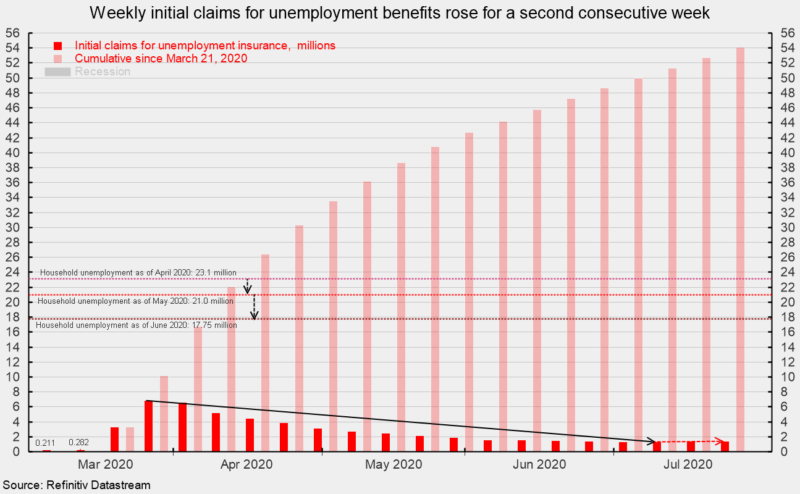Initial Claims for Unemployment Benefits Suggest Labor Market Recovery is Faltering
For a second week, initial claims for unemployment benefits rose slightly, suggesting labor-market conditions remain in flux as some workers are getting called back to work while others are still being cut. There are lingering concerns regarding the accuracy of the claims numbers as some states were burdened with huge backlogs of filings. Nevertheless, while reopening has helped some businesses recall some employees, the surge in new cases and deaths in many states attributed to COVID-19 has led some states to slow the process of reopening and, in some cases, reverse course. In addition, the potential for uncertainty, confusion, and risk aversion among consumers and businesses regarding the resurgence of COVID-19 cases puts the nascent recovery at great risk.
Initial claims for unemployment insurance totaled 1.434 million for the week ending July 25, a rise of 12,000 from the previous week’s 1.422 million. The results continue a run of nineteen consecutive weeks of historically massive claims following the implementation of business and consumer lockdowns intended to fight the COVID-19 pandemic (see chart). The rise in the latest week marks the second consecutive rise following a run of fifteen consecutive weeks of slowing claims after registering a record 6.87 million for the week ending March 28. Prior to the lockdowns, initial claims were running around 250,000, less than 1/5 their current level.
The number of ongoing claims totaled 17.02 million for the week ending July 18, up 867,000 from the prior week. The insured unemployment rate was 11.6 percent, up from 11.1 percent in the prior week.
The two most recent jobs reports (covering May and June) showed big gains in employment and big drops in unemployment, yet new claims for unemployment benefits posted a second week of increase and continue to run at historically high levels.
The national Employment Situation report for June was released on Thursday, July 2 and showed a gain of 4.8 million jobs following a 2.7 million rise in May, as reported in the establishment survey portion of the report. The total number of officially unemployed fell to 17.8 million in June, a drop of 3.2 million from the 21.0 million in May (and from 23.1 million in April – see chart). The number of officially unemployed in February before lockdowns were implemented was just 5.8 million, as reported in the household survey portion of the report.
The unemployment rate as measured in the employment report fell to 11.1 percent in June (though the Bureau of Labor Statistics noted that improper responses likely underreported the rate and it is likely about 1 point higher, near 12 percent) versus 13.3 percent in May (and nearly 20 percent if corrections were made to the April number). The previous cycle peak in the unemployment rate was 10 percent in October 2009 while the highest unemployment rate since 1950 came in November 1982 at 10.7 percent. Though data collection was much less reliable, the unemployment rate following the Great Depression was estimated to have peaked at about 25 percent in 1933.
The mixed results for some labor market data suggest the economic recovery may be hitting some difficulties. With new COVID-19 cases surging around much of the country, the emerging recovery is at great risk from consumer retrenchment and widespread reinstated lockdown policies.
The next Employment Situation report covering the month of July is due out on Friday, August 7. Consensus is for a gain of 2.3 million jobs in July and an unemployment rate of 10.3 percent.






